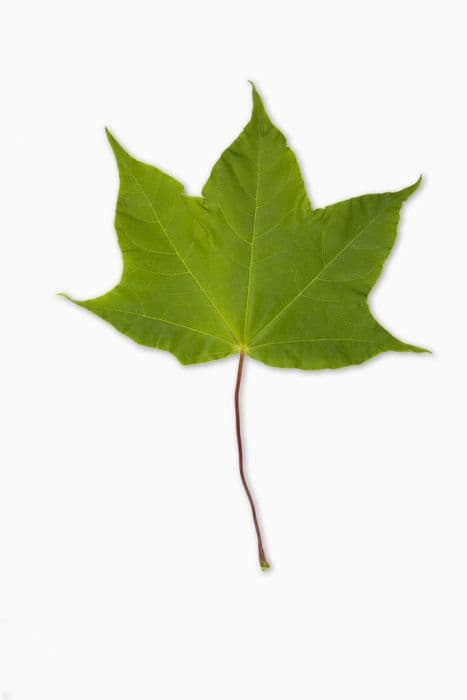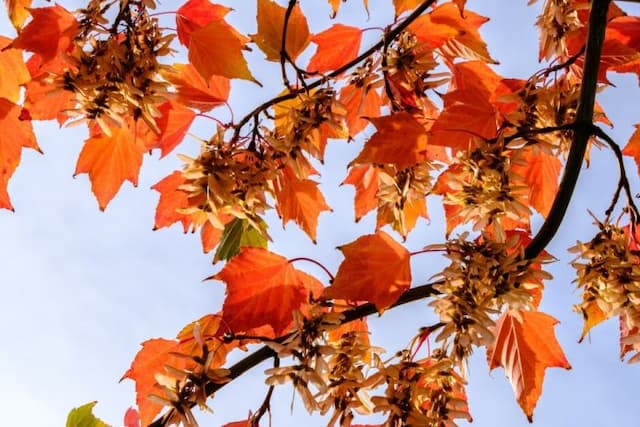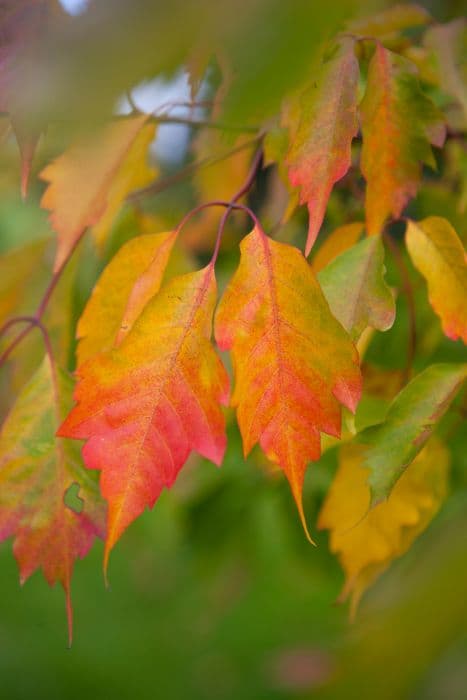Japanese Maple Acer palmatum 'Shaina' (P)

ABOUT
The Japanese Maple 'Shaina' is renowned for its striking foliage and elegant growth habit. This plant boasts leaves that are deeply lobed, with several sharply pointed tips that almost resemble the palm of a hand, hence the inclusion of 'palmatum' in its name. It stands out with its rich coloration; the leaves typically present a vibrant red hue that may transition to a reddish-purple as the seasons progress. During the spring, the Japanese Maple 'Shaina' leafs out with an exceptionally bright and bold red burst, creating a spectacular display of fresh color in the garden. As the plant matures through the summer, the intensity of the red may deepen, culminating in a fiery display of vivid foliage. This intense coloration remains a central feature of this plant, drawing the eye and serving as a focal point in many garden designs. In the fall, the Japanese Maple 'Shaina' is transformed yet again as the leaves take on a variety of tones. The reds may become richer and sometimes blend with shades of orange and even hints of gold, adding to the ornamental value of this delightful deciduous shrub. The autumnal color shift provides a striking contrast to the often green or browning hues of the surrounding vegetation, ensuring that the 'Shaina' remains a standout specimen. The growth habit of the Japanese Maple 'Shaina' is compact and upright, creating a rounded shape that is full and lush. The branching structure contributes to the picturesque silhouette of the plant, offering year-round interest even when the branches are bare. Throughout the growing season, the cascades of colorful leaves gently soften this sturdy framework, providing a delicate texture that contrasts beautifully with the more rigid limbs. In terms of its overall aesthetic, the Japanese Maple 'Shaina' is appreciated for its ability to convey both a sense of drama through its vivid coloration and a sense of serenity via its graceful growth pattern. This blend of visual attributes makes the 'Shaina' a cherished choice for ornamental gardens, where its unique presence can be enjoyed across the changing seasons.
About this plant
 Names
NamesFamily
Sapindaceae
Synonyms
Japanese Maple, Smooth Japanese Maple, Palmate Maple, Shaina Japanese Maple
Common names
Acer palmatum 'Shaina'
 Toxicity
ToxicityTo humans
Japanese Maple (Acer palmatum 'Shaina') is generally not considered toxic to humans. If ingested in large quantities, it may cause some stomach upset, but the plant is not known for having any significant toxic effects.
To pets
Japanese Maple is also considered to be non-toxic to cats and dogs. If a pet were to ingest a significant amount of this plant, mild gastrointestinal upset might occur, but it is not expected to cause serious harm or widespread toxicity.
 Characteristics
CharacteristicsLife cycle
Perennials
Foliage type
Deciduous
Color of leaves
Mixed
Height
5 feet (1.5 meters)
Spread
5 feet (1.5 meters)
Plant type
Shrub
Hardiness zones
5
Native area
Japan
Benefits
 General Benefits
General Benefits- Compact Size - P fits well in smaller gardens or spaces, ideal for urban gardens.
- Ornamental Value - With its attractive foliage and form, P is a highly decorative plant throughout the seasons.
- Seasonal Interest - It offers vibrant autumn colors, providing a seasonal display in the landscape.
- Shade Tolerance - P can grow in partial shade, offering flexibility in garden design.
- Drought Resistance - Once established, P can tolerate periods of dry conditions.
- Low Maintenance - It requires minimal pruning and care compared to many other ornamental plants.
- Wildlife Habitat - P can provide shelter and food for birds, as well as being attractive to butterflies.
- Winter Interest - Even in dormancy, the bare branches of P provide interesting shapes and structures in the winter landscape.
 Medical Properties
Medical PropertiesThis plant is not used for medical purposes.
 Air-purifying Qualities
Air-purifying QualitiesThis plant is not specifically known for air purifying qualities.
 Other Uses
Other Uses- Artistic Inspiration: The Japanese Maple 'Shaina' can provide a beautiful reference for artists and photographers, particularly in fall when its leaves are vibrant and strikingly colored.
- Bonsai: Skilled enthusiasts often use this cultivar to create bonsai trees due to its compact growth habit and attractive foliage.
- Education: Botanical gardens and horticulture programs use the Japanese Maple 'Shaina' to teach about plant care, pruning, and landscape design.
- Cultural Symbol: In some cultures, the Japanese Maple 'Shaina' is a symbol of peace and serenity and it may be planted to reflect these values in a garden setting.
- Feng Shui: The plant can be incorporated into gardens to enhance the Feng Shui, signifying balance and harmony.
- Seasonal Indicator: Its early spring blossoms and fall colors make it an excellent phenological indicator for monitoring the changing seasons in certain climate studies.
- Culinary Presentation: Although not edible, the leaves can be used to add a decorative element to the presentation of gourmet dishes at high-end restaurants.
- Winter Interest: Even when deciduous in winter, the bare intricate branching patterns of 'Shaina' can add visual interest to a stark winter landscape.
- Craft Materials: Fallen leaves may be used in crafting activities, such as leaf stamping or for creating botanical prints.
- Private Sanctuaries: The 'Shaina' variety, with its compact form and calming presence, can be a centerpiece in private meditation gardens or quiet reflective spaces.
Interesting Facts
 Feng Shui
Feng ShuiThe Japanese Maple is not used in Feng Shui practice.
 Zodiac Sign Compitability
Zodiac Sign CompitabilityThe Japanese Maple is not used in astrology practice.
 Plant Symbolism
Plant Symbolism- Peace and serenity: Japanese maples, in general, are often associated with tranquility due to their delicate leaves and calming presence in gardens, which can symbolize peace.
- Balance: The symmetrical shape of the 'Shaina' variety, along with its orderly growth pattern, can represent balance and harmony in one's life.
- Beauty and elegance: The refined structure and the beautiful color transitions throughout the seasons showcase nature's elegance, symbolizing beauty in change and diversity.
- Endurance and strength: As a hardy plant that can withstand various climates and conditions, this variety of Japanese maple can symbolize the ability to endure challenges.
- Welcoming: In Japanese culture, maple trees can symbolize hospitality, and placing a 'Shaina' at the entrance of a home may be intended to welcome guests.
 Water
WaterJapanese Maple 'Shaina' prefers consistent moisture with well-drained soil, requiring watering once or twice a week depending on weather conditions. During dry spells or in particularly hot climates, increase watering frequency to prevent the soil from drying out completely. A young 'Shaina' might require around 1-2 gallons per watering session to establish a strong root system. Once established, be attentive to the plant's needs rather than sticking to a strict schedule; overwatering can be as detrimental as under-watering. It's important to water the base of the tree and avoid wetting the foliage to reduce the risk of leaf scorch or fungal diseases.
 Light
LightJapanese Maples, including the 'Shaina' variety, thrive in locations with full sun to partial shade. They prefer morning sunlight with afternoon shade or dappled sunlight throughout the day, especially in zones with harsh afternoon sun. An ideal spot for 'Shaina' would be on the east or northeast side of a building or under the high, open canopy of larger trees.
 Temperature
TemperatureJapanese Maple 'Shaina' can tolerate a wide range of temperatures, from approximately -10 to 100 degrees Fahrenheit. It is hardy in USDA zones 5 through 8. The ideal temperature for promoting healthy growth and vibrant foliage is between 50 and 80 degrees Fahrenheit. Protecting the tree from harsh winter winds and extreme summer heat is crucial for its well-being.
 Pruning
PruningPruning Japanese Maple 'Shaina' should be done to maintain its health, to shape the tree, and to remove any dead or broken branches. Prune during the late winter or early spring before new growth starts. Light pruning can be done any time during the growing season except for late summer. The best time for major pruning is when the tree is dormant, which reduces stress and prevents sap loss that can attract insects.
 Cleaning
CleaningAs needed
 Soil
SoilJapanese Maple 'Shaina' prefers well-draining soil rich in organic matter with a pH between 5.5 and 6.5. A mix of loam, peat moss, and perlite or pine bark can work well for this compact cultivar. Ensure the soil allows for good aeration and water drainage to avoid root rot.
 Repotting
RepottingJapanese Maple 'Shaina' typically requires repotting every 2-3 years to prevent root-bound conditions and refresh the soil. Younger, fast-growing trees may need repotting more frequently, while mature, slower-growing specimens can be repotted less often.
 Humidity & Misting
Humidity & MistingJapanese Maple 'Shaina' tolerates average outdoor humidity levels but does not require high humidity. It can grow successfully in a range of ambient moisture conditions as long as it's not in an overly arid environment.
 Suitable locations
Suitable locationsIndoor
Place in bright, indirect light, shield from harsh sun.
Outdoor
Provide dappled shade, shelter from strong winds.
Hardiness zone
5-8 USDA
 Life cycle
Life cycleAcer palmatum 'Shaina,' commonly known as 'Shaina' Japanese Maple, begins its life cycle as a seed, which germinates in spring under the right temperature and moisture conditions. The seedling emerges and develops into a juvenile plant, producing its characteristic palmate leaves. As it matures, the tree experiences a period of vegetative growth, expanding in height and girth; this stage can last several years, during which the tree will also begin to develop a more complex root system. With the onset of sexual maturity, the 'Shaina' Japanese Maple produces small reddish-purple flowers in spring, although they may not be conspicuous compared to the foliage. Once pollinated, these flowers give way to samaras, winged seeds that are dispersed by wind, allowing the plant to reproduce. Across its life span, which can exceed 15 years, the tree experiences cycles of growth, flowering, and dormancy annually, typically with vivid foliage color changes in autumn before leaf fall.
 Propogation
PropogationPropogation time
Spring-Early Summer
Propogation: For Japanese Maple 'Shaina', the most popular propagation method is through softwood cuttings. This method is typically performed in late spring or early summer when new growth is just beginning to harden but is still flexible. Cuttings are taken from healthy branches with a sharp, sterile knife or pruners to make a cut about 4 to 6 inches (approximately 10 to 15 centimeters) long, ensuring each cutting has at least two or three sets of leaves. The bottom leaves are carefully removed, and the cut end is dipped in a rooting hormone to encourage root development. The prepared cuttings are then inserted into a well-draining rooting medium such as a mix of perlite and peat, kept moist, and placed in indirect light. A plastic cover can be used to maintain high humidity around the cuttings. Roots usually develop within a few weeks, after which the cuttings can gradually be acclimatized to normal growing conditions.









